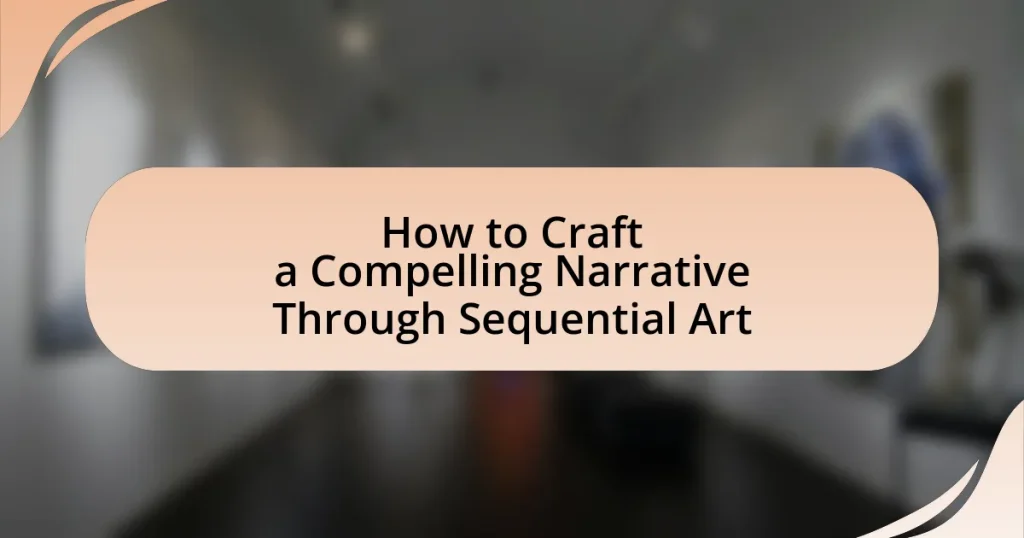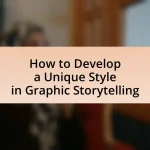Sequential art is a visual storytelling medium that combines images and text to convey narratives, playing a vital role in narrative crafting. This article explores the definition of sequential art, its historical origins, and its evolution over time, highlighting key elements such as character development, pacing, and visual techniques that enhance storytelling. It also addresses the importance of integrating dialogue and captions, common pitfalls to avoid, and practical tips for improving narrative quality. Additionally, resources for aspiring sequential artists are provided to support their development in crafting compelling narratives through sequential art.
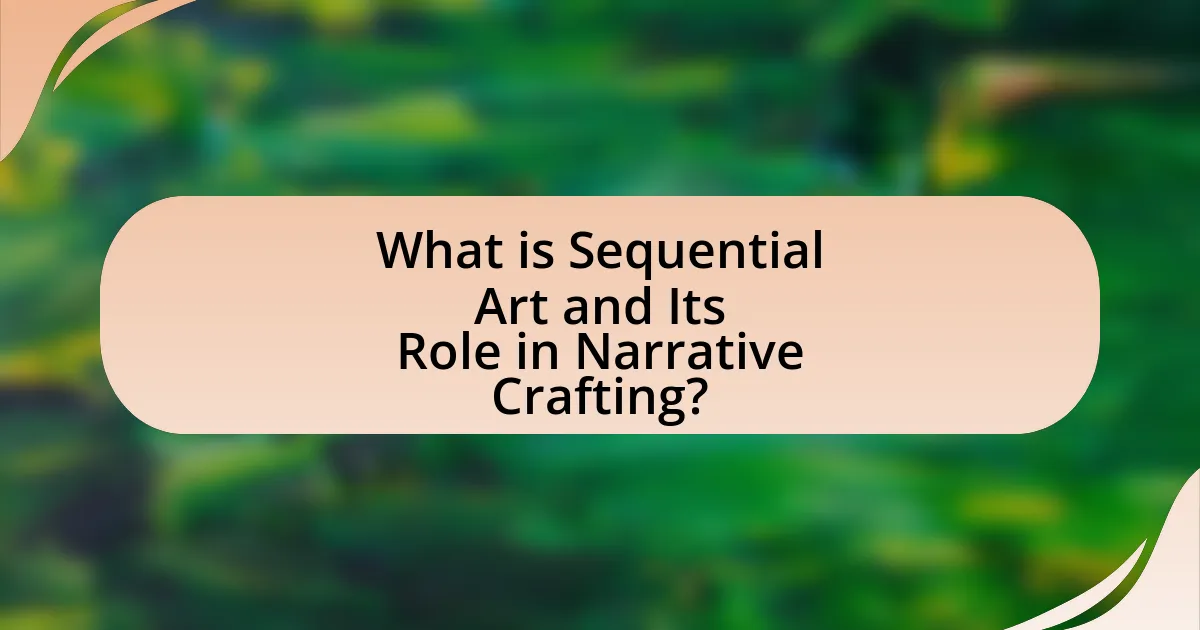
What is Sequential Art and Its Role in Narrative Crafting?
Sequential art is a form of visual storytelling that combines images and text to convey a narrative. This medium plays a crucial role in narrative crafting by allowing creators to depict complex stories through a sequence of images, often accompanied by dialogue or captions, which guide the reader’s understanding and emotional engagement. For instance, comic books and graphic novels utilize sequential art to illustrate character development, plot progression, and thematic elements, effectively enhancing the storytelling experience. The interplay between visuals and text in sequential art can evoke emotions and create a more immersive narrative, as evidenced by the success of works like “Maus” by Art Spiegelman, which demonstrates how sequential art can address profound themes such as trauma and memory.
How does sequential art differ from other forms of storytelling?
Sequential art differs from other forms of storytelling primarily through its use of visual sequences to convey narrative. This medium combines images and text in a structured format, allowing for a unique interplay between visual representation and written dialogue or narration. Unlike traditional prose, which relies solely on text to build imagery and context, sequential art utilizes panels and illustrations to create a dynamic flow of time and action, enabling readers to experience the story in a more immediate and immersive way. For instance, comic books and graphic novels employ this technique to guide readers through a visual journey, where the arrangement of images can influence pacing and emotional impact, a feature not present in linear text-based storytelling.
What are the key elements that define sequential art?
Sequential art is defined by the combination of images and text arranged in a specific order to convey a narrative. The key elements include panels, which are the individual frames that contain images; gutters, the spaces between panels that indicate the passage of time or change in action; and visual storytelling techniques, such as composition, color, and line work that enhance the narrative. Additionally, the integration of dialogue and captions within the panels provides context and character development, further enriching the storytelling experience. These elements work together to create a cohesive and engaging narrative that can be easily interpreted by the audience.
Why is visual storytelling important in narrative construction?
Visual storytelling is important in narrative construction because it enhances comprehension and emotional engagement. By combining images with text, visual storytelling allows audiences to process information more quickly and effectively, as studies show that visuals can increase retention rates by up to 65%. This method also evokes emotions more powerfully, as visuals can convey complex feelings and themes that words alone may struggle to express. For instance, in graphic novels, the interplay between illustrations and narrative creates a multi-layered experience that deepens the audience’s connection to the story.
What are the historical origins of sequential art?
The historical origins of sequential art can be traced back to ancient civilizations, particularly in Mesopotamia and Egypt, where narrative storytelling was depicted through a series of images. These early forms included pictographs and hieroglyphs that conveyed stories and events in a sequential manner. For example, the Trajan’s Column in Rome, built around 113 AD, illustrates a continuous narrative through relief sculptures that depict the story of Emperor Trajan’s victory in the Dacian Wars. This use of sequential imagery laid the groundwork for modern comics and graphic novels, demonstrating how visual storytelling has evolved over centuries to convey complex narratives effectively.
How has sequential art evolved over time?
Sequential art has evolved significantly from ancient storytelling methods to modern graphic novels and digital comics. Initially, sequential art appeared in ancient civilizations, such as the Egyptians, who used hieroglyphics and images to narrate stories on temple walls. This form of storytelling laid the groundwork for later developments, including illuminated manuscripts in the Middle Ages, which combined text and images to convey narratives.
In the 19th century, the advent of printing technology allowed for the mass production of comic strips, with notable examples like “The Yellow Kid” in 1895, which popularized the comic format in newspapers. The 20th century saw the rise of comic books, particularly in the United States, with superhero genres gaining immense popularity, exemplified by characters like Superman and Batman introduced in the late 1930s.
The late 20th and early 21st centuries marked a further evolution with the emergence of graphic novels, which offered more complex narratives and artistic styles, as seen in works like “Maus” by Art Spiegelman and “Persepolis” by Marjane Satrapi. Additionally, digital platforms have transformed sequential art, allowing for interactive storytelling and webcomics, broadening accessibility and audience engagement.
This evolution reflects changes in technology, culture, and artistic expression, demonstrating how sequential art has adapted to meet the needs and preferences of its audience over time.
What cultural influences have shaped sequential art?
Sequential art has been shaped by various cultural influences, including mythology, religion, and social movements. For instance, ancient civilizations like Egypt and Greece utilized sequential imagery in their hieroglyphs and friezes to tell stories, reflecting their cultural narratives and beliefs. Additionally, the rise of comic books in the 20th century was influenced by social issues such as World War II and civil rights movements, which were depicted in the narratives of superheroes and graphic novels, showcasing the societal context of the time. These cultural elements have continuously informed the themes, styles, and storytelling techniques within sequential art, making it a reflection of the evolving human experience.
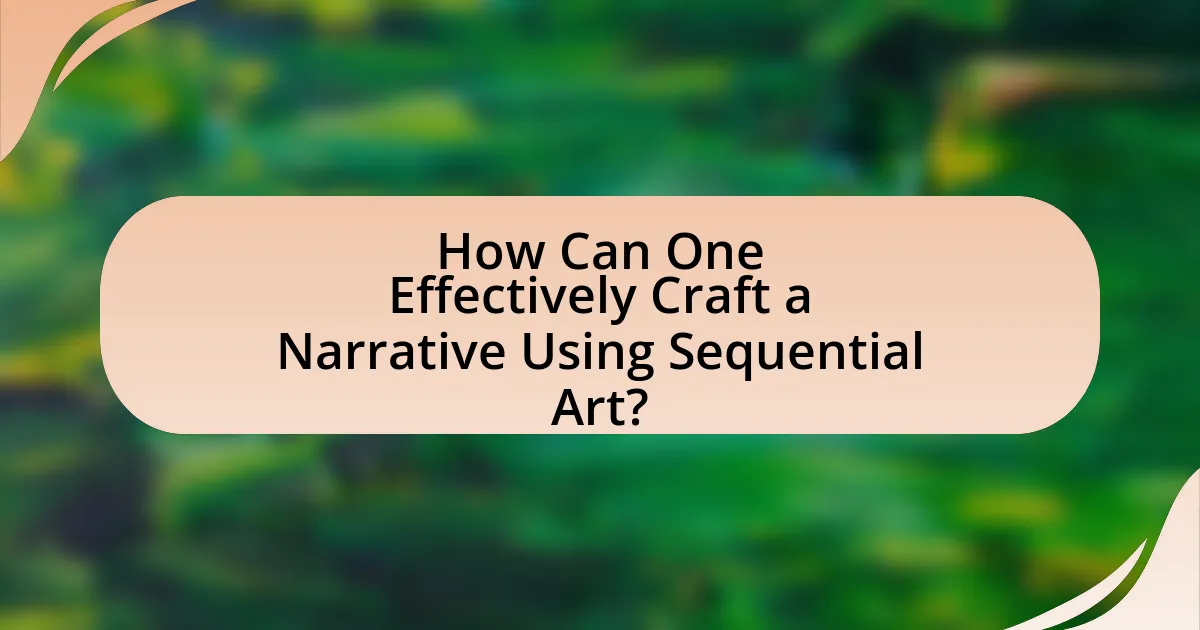
How Can One Effectively Craft a Narrative Using Sequential Art?
To effectively craft a narrative using sequential art, one must focus on the integration of visual storytelling elements such as composition, pacing, and character development. Sequential art relies on the arrangement of images and text to convey a story, where each panel serves as a building block that guides the reader through the narrative. For instance, the use of varying panel sizes can influence the pacing; larger panels may emphasize key moments, while smaller panels can create a sense of urgency. Additionally, character expressions and body language within the artwork are crucial for conveying emotions and motivations, enhancing the reader’s connection to the story. Studies, such as those by Scott McCloud in “Understanding Comics,” highlight that the interplay between visuals and text is essential for effective storytelling, as it allows for a deeper engagement with the narrative.
What are the essential components of a compelling narrative in sequential art?
The essential components of a compelling narrative in sequential art include character development, plot structure, visual storytelling, and thematic depth. Character development allows readers to connect emotionally with the protagonists, while a well-structured plot provides a clear beginning, middle, and end, guiding the audience through the story. Visual storytelling utilizes images to convey action, emotion, and context, enhancing the narrative experience. Thematic depth adds layers of meaning, encouraging readers to engage with the underlying messages. These components work together to create an immersive and impactful narrative in sequential art.
How do character development and arcs contribute to the narrative?
Character development and arcs are essential components that enhance the narrative by providing depth and relatability to characters. Through character development, individuals undergo transformations that reflect their experiences, motivations, and conflicts, which in turn drive the plot forward. For instance, a character’s journey from insecurity to confidence can create emotional stakes that engage the audience, making them invested in the outcome.
Moreover, character arcs, which outline the progression of a character’s growth or decline, establish a framework for the narrative structure. This progression often aligns with key plot points, allowing for a cohesive storytelling experience. A well-defined arc can illustrate themes such as redemption or sacrifice, reinforcing the narrative’s core message.
Research indicates that narratives with strong character arcs are more likely to resonate with audiences, as they foster empathy and connection. For example, a study published in the Journal of Narrative Theory highlights that characters who evolve in response to their circumstances create a more compelling and immersive experience for the audience. Thus, character development and arcs are pivotal in shaping the narrative’s emotional landscape and thematic depth.
What role does pacing play in storytelling through sequential art?
Pacing is crucial in storytelling through sequential art as it controls the rhythm and flow of the narrative. Effective pacing allows creators to manipulate the timing of events, guiding the reader’s emotional response and engagement with the story. For instance, a rapid sequence of panels can create tension and urgency, while slower pacing can evoke reflection and contemplation. Studies in visual storytelling demonstrate that varying the number of panels per page and the size of those panels can significantly impact how a story is perceived, influencing the reader’s experience and understanding of the narrative arc.
How can visual elements enhance narrative delivery?
Visual elements enhance narrative delivery by providing immediate context and emotional resonance that words alone may not convey. For instance, illustrations can depict character emotions, settings, and actions, allowing readers to grasp the story’s tone and atmosphere quickly. Research indicates that visual storytelling can improve comprehension and retention; a study published in the journal “Cognitive Science” found that people remember information better when it is presented with relevant images compared to text alone. This synergy between visuals and narrative fosters a more immersive experience, engaging the audience on multiple sensory levels.
What techniques can be used to convey emotion through visuals?
Techniques to convey emotion through visuals include color theory, composition, facial expressions, and body language. Color theory utilizes specific hues to evoke feelings; for instance, warm colors like red can signify passion or anger, while cool colors like blue can represent calmness or sadness. Composition affects emotional impact by guiding the viewer’s eye and creating tension or harmony; for example, asymmetrical arrangements can evoke unease. Facial expressions are crucial as they directly communicate emotions, with studies showing that viewers can identify emotions like happiness or fear through subtle changes in facial features. Body language further enhances emotional expression; open postures may convey confidence or joy, while closed postures can indicate sadness or defensiveness. These techniques are supported by psychological research indicating that visual elements significantly influence emotional perception in art and media.
How does composition affect the reader’s understanding of the story?
Composition significantly influences the reader’s understanding of a story by organizing visual elements and narrative flow. Effective composition guides the reader’s eye, establishes pacing, and emphasizes key moments, thereby enhancing emotional engagement and clarity. For instance, the use of panel arrangement can create tension or tranquility, directly impacting how the reader perceives the unfolding events. Research in visual storytelling indicates that well-structured compositions can lead to improved comprehension and retention of narrative details, as seen in studies on graphic novels and comics, where layout choices correlate with reader engagement levels.
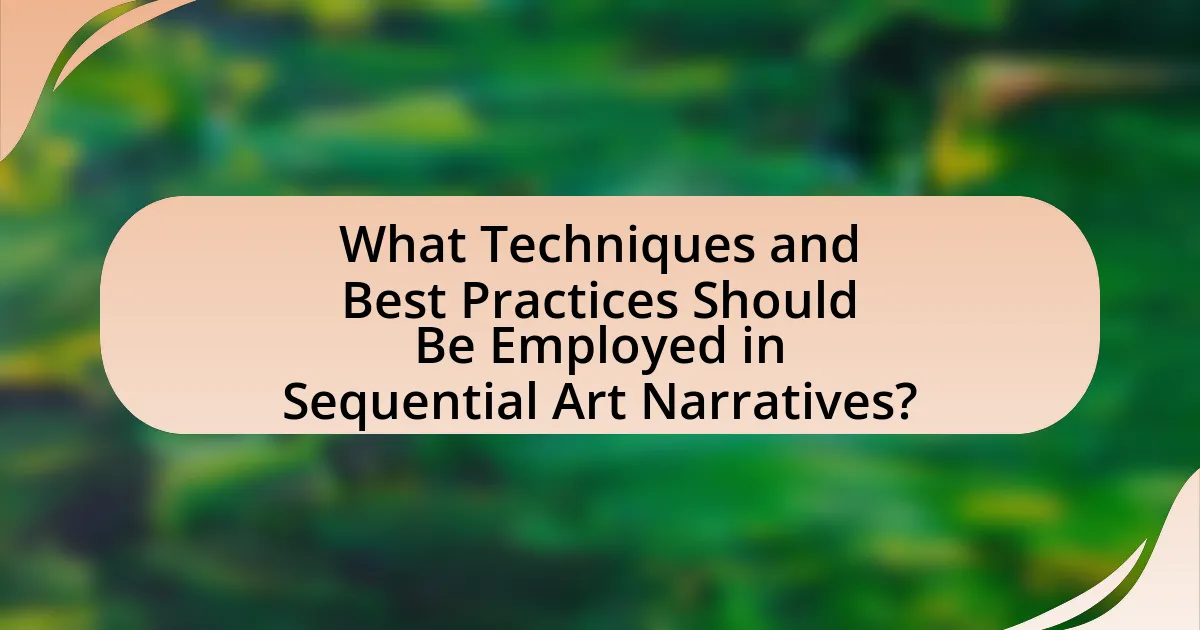
What Techniques and Best Practices Should Be Employed in Sequential Art Narratives?
Effective techniques and best practices in sequential art narratives include the use of visual storytelling, pacing, and panel composition. Visual storytelling relies on the interplay between images and text to convey emotions and actions, allowing readers to engage with the narrative on multiple levels. Pacing, achieved through the arrangement of panels and the timing of visual elements, controls the flow of the story, guiding the reader’s experience and enhancing dramatic tension. Panel composition, which involves the size, shape, and placement of panels, influences how information is presented and can create emphasis on key moments.
For instance, a study by Scott McCloud in “Understanding Comics” emphasizes that the arrangement of panels can manipulate time and space, affecting how readers perceive the narrative. Additionally, employing techniques such as varying panel sizes to highlight climactic moments or using gutters (the spaces between panels) to create pauses can significantly enhance storytelling. These practices collectively contribute to a more immersive and compelling narrative experience in sequential art.
How can one effectively use dialogue and captions in sequential art?
One can effectively use dialogue and captions in sequential art by ensuring that they complement the visual storytelling and enhance character development. Dialogue should be concise and reflect the characters’ personalities, while captions can provide context or internal thoughts that are not visually represented. For instance, in graphic novels like “Maus” by Art Spiegelman, dialogue and captions work together to convey complex emotions and historical context, enriching the narrative. This synergy between text and imagery allows readers to engage more deeply with the story, making the overall experience more immersive and impactful.
What are the best practices for integrating text and visuals?
The best practices for integrating text and visuals include ensuring clarity, maintaining balance, and enhancing engagement. Clarity is achieved by using legible fonts and appropriate sizes for text, ensuring that visuals complement rather than overwhelm the message. Maintaining balance involves distributing text and visuals evenly across the layout, preventing clutter and allowing for easy navigation. Enhancing engagement can be accomplished by using visuals that evoke emotions or illustrate key points, thereby reinforcing the narrative. Research indicates that well-integrated text and visuals can improve comprehension by up to 89%, as shown in studies by Mayer (2009) on multimedia learning.
How can dialogue enhance character voice and personality?
Dialogue enhances character voice and personality by providing a direct means for characters to express their thoughts, emotions, and unique traits. Through specific word choices, speech patterns, and interactions, dialogue reveals individual backgrounds, motivations, and relationships. For instance, a character who uses slang may indicate a youthful or rebellious personality, while formal language can suggest education or social status. Research in narrative theory shows that dialogue can significantly influence reader perception, as it shapes how characters are understood and related to, thereby deepening the narrative experience.
What common pitfalls should be avoided when crafting narratives in sequential art?
Common pitfalls to avoid when crafting narratives in sequential art include poor pacing, lack of character development, and unclear visual storytelling. Poor pacing disrupts the flow of the narrative, making it difficult for readers to engage; for instance, rushing through key moments can lead to confusion. Lack of character development results in flat characters that fail to resonate with the audience, diminishing emotional investment. Unclear visual storytelling can obscure the intended message, as seen when panels do not effectively guide the reader’s eye or when transitions between scenes are jarring. Each of these pitfalls can significantly undermine the effectiveness of the narrative in sequential art.
How can over-reliance on visuals detract from storytelling?
Over-reliance on visuals can detract from storytelling by overshadowing narrative depth and character development. When visuals dominate, they may lead to a superficial understanding of the plot, as audiences might focus more on imagery than on the underlying themes or emotional arcs. Research indicates that effective storytelling requires a balance between visual elements and textual or contextual information; for instance, a study published in the Journal of Visual Literacy highlights that narratives lacking sufficient textual context can result in misinterpretation of character motivations and plot significance. Thus, while visuals enhance engagement, excessive dependence on them can compromise the richness and complexity of the story being told.
What mistakes do novice creators often make in narrative structure?
Novice creators often make the mistake of neglecting the importance of a clear narrative arc, which typically includes exposition, rising action, climax, falling action, and resolution. This oversight can lead to disjointed storytelling, where events feel random or unconnected, ultimately confusing the audience. Additionally, they frequently fail to develop well-rounded characters, resulting in flat or unrelatable figures that do not drive the narrative forward. Research indicates that stories with strong character development and a coherent structure are more engaging and memorable for audiences.
What practical tips can help improve narrative crafting in sequential art?
To improve narrative crafting in sequential art, focus on clear visual storytelling, character development, and pacing. Clear visual storytelling involves using panel layouts and transitions effectively to guide the reader’s eye and convey the story’s flow. Character development is essential; creating relatable and dynamic characters enhances emotional engagement, as seen in successful works like “Maus” by Art Spiegelman, where character depth drives the narrative. Pacing, achieved through the strategic use of dialogue and action sequences, helps maintain reader interest and builds tension, as demonstrated in “Watchmen” by Alan Moore, where the pacing contributes significantly to the overall impact of the story.
How can feedback and critique enhance narrative quality?
Feedback and critique enhance narrative quality by providing diverse perspectives that identify strengths and weaknesses in storytelling. When creators receive constructive criticism, they can refine plot structures, character development, and thematic depth, leading to a more engaging narrative. Research indicates that narratives subjected to peer review often exhibit improved coherence and emotional resonance, as seen in studies by the University of Southern California, which found that collaborative feedback processes significantly elevate narrative effectiveness. This iterative process of receiving and implementing feedback fosters a deeper understanding of audience expectations and enhances overall narrative impact.
What resources are available for aspiring sequential artists to learn from?
Aspiring sequential artists can learn from a variety of resources, including online courses, books, workshops, and mentorship programs. Online platforms like Skillshare and Coursera offer courses specifically focused on sequential art techniques and storytelling. Books such as “Understanding Comics” by Scott McCloud provide foundational knowledge on visual storytelling, while “Making Comics” by the same author offers practical exercises. Workshops hosted by art schools or comic conventions allow for hands-on experience and networking with professionals. Additionally, mentorship programs, such as those offered by the Comic Book Legal Defense Fund, connect emerging artists with industry veterans for guidance and feedback. These resources collectively support the development of skills necessary for crafting compelling narratives through sequential art.
